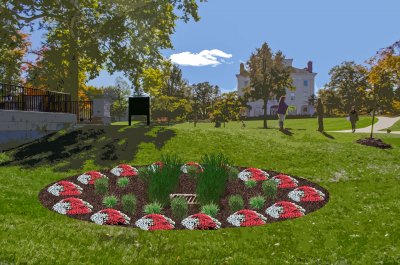Beauty and Function
Ohio Wesleyan Student Spearheads Creation of University’s Third Rain Garden

With climate change, water rights, and environmental politics dominating world discussions, Ohio Wesleyan University student Kayla Adolph ’20 of Toledo, Ohio, is addressing the issues on campus with a project 10 months in the making.
Collaborating with OWU students, faculty, and staff, as well as workers from the City of Delaware, Adolph spearheaded the installation of a rain garden this fall on the west side of Merrick Hall. The garden is the result of a project in professor John Krygier’s spring 2019 course, Geography 360: Environmental Geography.
“In Dr. Krygier’s Environmental Geography class, we were asked to come up with projects to improve the school’s sustainability, and these projects took all semester to plan,” says Adolph, a double-major in Geography and in Politics and Government with a French minor. “At times it was difficult to be working on something that had to evolve so much to make the final approval.”
The “rain garden” is technically a bioretention cell designed to reroute rainwater for plant usage instead of being deposited into storm drains. Plants growing in rain gardens are able to catch and absorb pollution in the groundwater and “have the ability to reduce the amount of pollution reaching nearby streams and rivers by 30%,” Adolph explains.

“Aside from their function, rain gardens can vary greatly in size, shape, and plants used,” says Adolph, who selected white and red phloxes, Pennsylvania sedges, and Evergold sedges to make up OWU’s third bioretention cell.
The plants were chosen “because they are very hardy and look beautiful all year round. The white and red phloxes match school colors,” she says.
“I had to make sure the garden fit the University’s aesthetic needs, as well as serving as an effective bioretention cell, and knowing that it was possible to attain both was all the more satisfying,” Adolph says.
She also is excited by the Merrick Hall site, with graduation and convocation taking place on the building’s front lawn. “The location of Merrick Hall is very special,” Adolph says.
Professor Krygier, co-director of OWU’s Environment and Sustainability Program, says the location resulted in a unique garden design.
“Rain gardens tend to have a scruffy, non-manicured design to them,” he says. “This is a modification of what you would normally do in order to fit the campus aesthetic.”
OWU’s first two rain gardens, located outside Branch Rickey Arena, are more traditional in design.
Krygier says additional water-related projects are in the works, with a focus on improving water in the Delaware Run and Olentangy River.
“The Olentangy has a slew of problems, including agricultural and lawn-chemical runoff,” says Krygier, explaining that parking and street runoff contributes to the problem, adding cigarette butts, salt, and oil.
“Parking lots are impermeable surfaces, so when it rains the water and pollutants pour directly into the waterways,” Krygier says.
In addition, he says, Ohio Wesleyan is planning to participate in the Environmental Protection Agency’s 2019 RainWorks Challenge, described as “a green infrastructure design competition ... to engage with the next generation of environmental professionals, foster a dialogue about the need for innovative stormwater management techniques, and showcase the environmental, economic, and social benefits of green infrastructure practices.”
Working with the OWU Buildings and Grounds Department, Krygier says, a master plan for Ohio Wesleyan’s runoff drainage systems is in the works.
